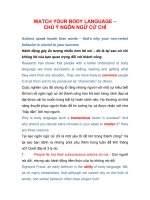Body language
Bạn đang xem bản rút gọn của tài liệu. Xem và tải ngay bản đầy đủ của tài liệu tại đây (1.4 MB, 26 trang )
Business Communication
Nonverbal
communicati
on
and use of
body
language
What is Communication?
Communication is……………
Communication in general
is process of sending and
receiving messages that
enables humans to share
knowledge, attitudes, and
skills.
Although we usually identify
communication with speech,
communication is composed
of two dimensions - verbal
and nonverbal.
What are some forms of
nonverbal communication?
Nonverbal
communication
includes
•
facial expressions,
•
eye contact,
•
tone of voice,
•
body posture and
motions,
•
positioning within
groups.
•
It may also include
the way we wear our
clothes or the silence
we keep.
BODILY SPEAKING…
According to the social
anthropologist, Edward T.
Hall, in a normal
conversation between two
persons,
less than 35% of the social
meanings is actually
transmitted by words.
So, at least 65% of it is
conveyed through the
body (nonverbal channel).
Have you ever heard
anyone say, "His actions
spoke so loudly I couldn't
hear what he said?"
Categories
•
Physical. This is the
personal type of
communication. It
includes facial
expressions, tone of
voice, sense of
touch, sense of
smell, and body
motions.
•
Aesthetic. This is the type of communication
that takes place through creative
expressions: playing instrumental music,
dancing, painting and sculpturing.
Signs
Use of various signs in non verbal
communication
•
Symbolic. This is the type of communication that
makes use of religious, status, or ego-building
symbols.
•
Kinesics (body language) Body motions such as shrugs, foot
tapping, drumming fingers, eye movements such as winking,
facial expressions, and gestures
•
Proxemics (proximity) Use of space to signal privacy or attraction
•
Haptics Touch
•
Oculesics Eye contact
•
Chronemics Use of time, waiting, pausing
•
Olfactics Smell
•
Vocalics Tone of voice, timbre, volume, speed
•
Sound symbols Grunting, mmm, er, ah, uh-huh, mumbling
•
Silence Pausing, waiting, secrecy
•
Posture Position of the body, stance
•
Adornment Clothing, jewellery, hairstyle
•
Locomotion Walking, running, staggering, limping
Physical aspects of nonverbal
communication.
Facial Expressions
•
Face is the index
of Mind
•
The eyes, the
lips and the
muscles express
many feelings
•
It can also be
deceived by
manipulation
The Eyes
•
Stare or fixed gaze
suggest involvement
or wonder or eye
disapproval.
•
Raised looks show
dominance.
•
Downcast looks
suggest weakness and
submission
•
Direct eye contact
communicates
honesty, transparency
and neutral attitude.
Gestures and Postures
Positive Gestures
•
Open Palms
•
Eye-to-eye confrontation
•
Smile
•
Equal Handshake
Postures
•
Standing position
•
Walking style
•
Hand Movements
NONVERBAL
BEHAVIOR
INTERPRETATION
Brisk, erect walk Confidence
Standing with hands on
hips
Readiness, aggression
Sitting with legs
crossed, foot kicking
slightly
Boredom
Sitting, legs apart Open, relaxed
Arms crossed on chest Defensiveness
Walking with hands in
pockets, shoulders
hunched
Dejection
NONVERBAL
BEHAVIOR
INTERPRETATION
Hand to cheek Evaluation, thinking
Touching, slightly
rubbing nose
Rejection, doubt, lying
Rubbing the eye Doubt, disbelief
Hands clasped behind
back
Anger, frustration,
apprehension
Locked ankles Apprehension
Head resting in hand,
eyes downcast
Boredom
Rubbing hands Anticipation
A Small Class Exercise
So What Does This Mean?
•
Let me see!
•
Authoritative
•
Pondering
•
Thinking
•
Considering
So What Does This Mean?
•
Can I help!
•
Trust me!
•
You’re in
good hands!
•
Helping Hand
So What Does This Mean?
•
Dejected
•
Disappointed
•
Lost it.
So What Does This Mean?
•
Now just stop
that!
•
Get out of
here!
•
Defensive
•
Oppositional
So What Does This Mean?
•
So tell me
more!
•
Open
•
Accepting
•
Welcoming









